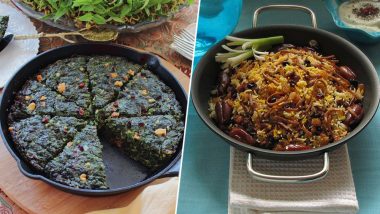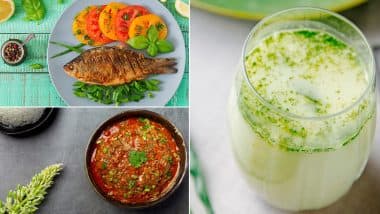In India, Parsi New Year 2018 will be celebrated today i.e. August 17. Also called as Nowruz, Parsi community gather today to mark the occasion and celebrate it with great enthusiasm with friends and family. After offering special prayers, the community indulge in preparing delicious feasts. All kinds of sweets, pastries and sherbets are eaten in large amounts during Nowruz. Some of the popular dishes include, Kookoo Sabzi, Reshteh Polo and Shirin Polo. Parsi New Year 2018: Date, History, Significance and Celebrations of Pateti & Nowruz.
In India, the Parsi community who follow Zoroastrianism celebrate Nowruz with great fervour. Parsis visit the Fire Temple where prayers are offered. Families come together and celebrate the day. Below are the recipes of the dishes to enjoy the delicious and rich Iranian cuisine.
Recipes for Parsi New Year 2018
1. Kookoo Sabzi
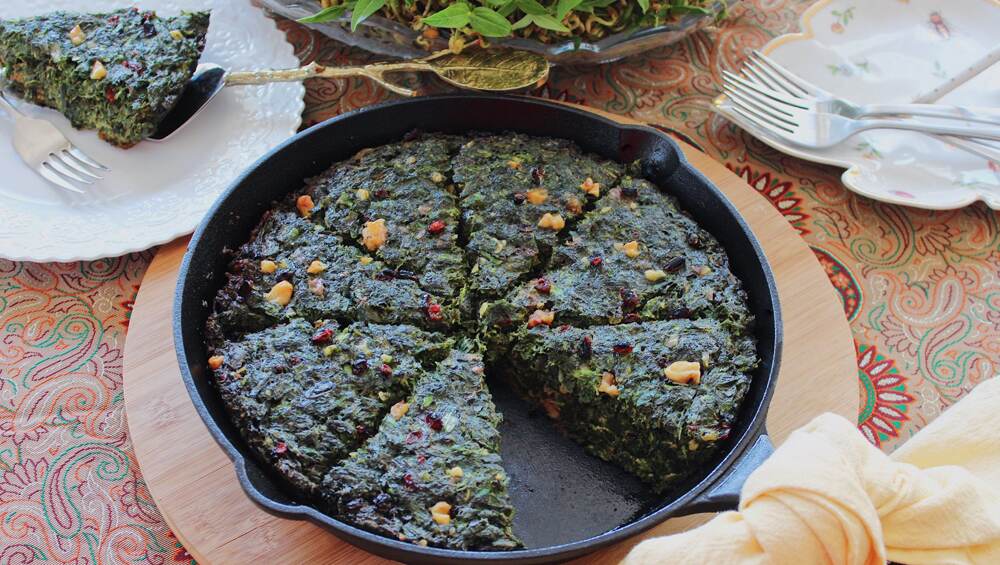
A kookoo also spelled as kookoo-ye, kuku or kou-kou – is an Iranian open-faced omelette like that to an Italian frittata. There are many variations of this using a variety of fillings and flavourings. Kookoo sabzi is probably the most popular dish and flavoured with a mix of fresh herbs which also give a tint of deep emerald green.
Ingredients
- Butter or oil – 2 tbsp
- Scallions (chopped) – 1 bunch
- Parsley (chopped) – 1 bunch
- Cilantro (chopped) – ½ bunch
- Dill (chopped) – ½ bunch
- Eggs – 8
- Turmeric – 1 tsp
- Salt – ½ tsp
- Pepper – ¼ tsp
Method
- Preheat oven to 350˚F. Heat the butter or oil in an ovenproof sauté pan or skillet over medium flame. Add the scallions, parsley, cilantro and dill and sauté until the herbs are partially cooked for around 2 to 3 minutes. Remove from the pan and set aside to cool.
- Wipe the pan with a paper towel. Add the eggs, turmeric, salt and pepper to a large bowl and beat until smooth. Stir in the cooled herbs.
- Pour the eggs back into the sauté pan and place the pan in the preheated oven. Bake for 20 to 25 minutes or until the eggs are fully set.
- Run a knife around the edges of the kookoo and invert onto a serving platter. Cut into wedges and serve or cold with a garnish of plain yogurt.
2. Reshteh Polo
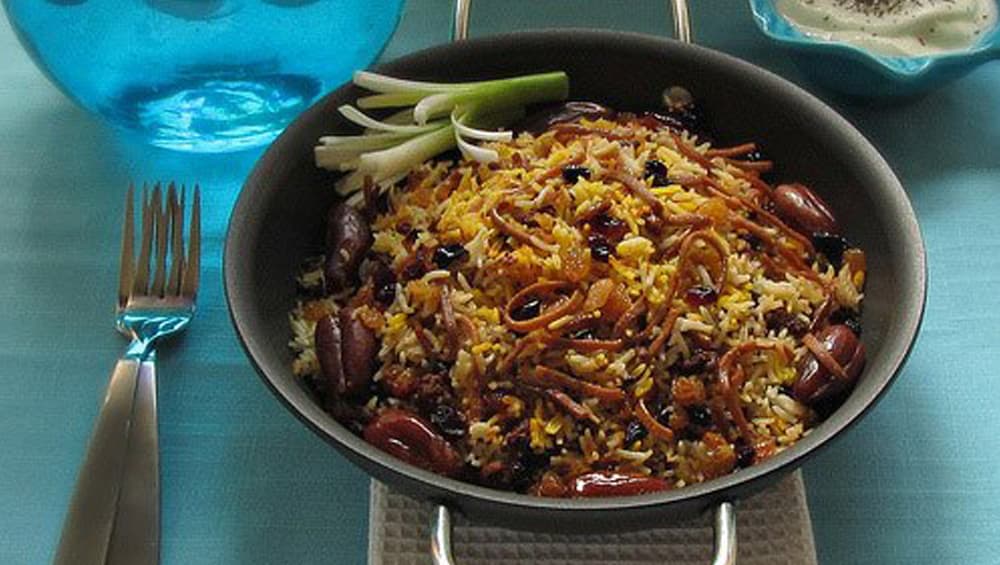
Reshteh polo is a pilaf made with a mixture of rice and toasted noodles that is traditionally served in many Iranian homes on the night before the spring festival of Nowruz. Parboiled rice and noodles are layered with an aromatic meat mixture and gently steamed in the traditional polo manner.
Ingredients
- Basmati rice – 2 cups
- Oil – 2 to 3 tbsp
- Reshteh or other noodles – 4 ounces
- Lamb or beef cut into chunks – 1 ½ pounds
- Onion (minced) – 1
- Cinnamon – 2 tbsp
- Turmeric – 1 tsp
- Orange peel – 1 piece
- Salt & Pepper – to taste
- Dates – ¼ cup
- Raisins – ¼ cup
- Warm water – ½ cup
- Saffron (optional) – a pinch
- Butter (melted) – 3 tbsp
Method
- Wash the rice a couple of times to remove excess starch. Soak the rice for at least 2 to 3 hours.
- Add oil to a large, heavy-bottomed pot and heat over medium flame. Break the resteh or other noodles into pieces about 2 inches long. Toss the noodles into the oil and saute, stirring constantly, until lightly toasted. Remove and set aside.
- Add more oil in the pot, if needed. Stir the chunks of meat and brown on all sides. Remove and set aside.
- Add the onions, cinnamon and turmeric and saute until the onions are translucent and lightly browned. Add the browned meat, 1 cup of water, the orange peel, salt and pepper. Bring it to a boil and reduce heat to medium-low, cover and simmer for about 45 minutes or until the meat is cooked through and tender. Stir in the raisins and dares and simmer for another minute or two. Remove the meat mixture and set aside in a large bowl.
- Clean the pot and add a large amount of water to the pot along with a big pinch of salt. Bring the salted water to a boil. Stir in the rice and let it cook for 2 minutes. Next stir in the toasted reshteh or other noodles and cook for another 2 or 3 minutes. Drain the rice and noodles in a colander lined with a clean towel and immediately rinse with cool water.
- Soak the saffron in warm water. Rinse out the pot you cooked the rice in and add the melted butter to cover the bottom of the pot. Pour half of the rice and noodles into the pot and spread it evenly over the bottom. Spread the meat mixture evenly over the layer of rice. Then spread the remaining rice evenly over the meat. Pour the saffron-scented water over the top layer of rice.
- Use the handle of a wooden spoon to poke 5 or 6 holes down into the rice all the way to the bottom of the pot (this allows steam to penetrate the rice). Cover the pot with a clean dish towel and then tightly with a lid. Wrap the sides of the towel up over the top of the lid. The towel keeps condensed steam from dripping back down into the rice.
- Place the pot on high heat for 5 minutes, then reduce to low and steam for about 45 minutes. Remove the pot from heat and let rest for 5 to 10 minutes.
- Carefully invert the pot onto a large serving dish to pour out the rice. Serve the crusty rice from the bottom of the pot – the tahdiq – crumbled over the top.
3. Sabzi Polo ba Mahi
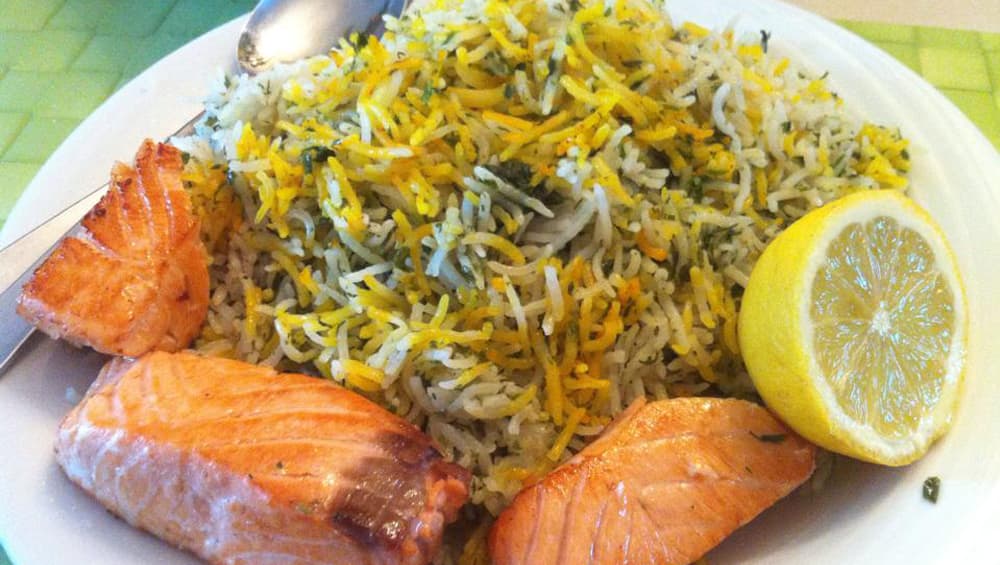
Sabzi polo is a green version of the famous Persion polo or pilaf, rice dishes. The green comes from a variety of herbs that give an otherwise plain dish a sublime flavour. The dish paired with fried fish will give you sabzi polo ba mahi, the traditional Nowruz Persian New Year meal.
Ingredients
- Basmati rice – 3 cups
- Scallions (minced) – 2 bunches
- Dill weed (finely chopped) – 1 cup
- Parsley (finely chopped) – 1 cup
- Cilantro (finely chopped) – 1 cup
- Oil or melted butter – 1/3 cup
- Stock or water – 2 cups
Method
- In a large bowl, wash and drain the rice in 2 or 3 changes of water. Add more water to cover and set the rice aside to soak for 1 to 2 hours.
- Bring a large pot of salted water to a boil. Drain the soaked rice and stir it into the boiling water. Return to a boil and cook the rice for 2 to 3 minutes. Then drain the rice, discarding the water.
- Mix the scallions, dill, parsley and cilantro together. Spread the oil or melted butter over the bottom of the pot you used to boil the rice. Spread one-third of the rice over the bottom of the pot. Next spread 1/2 of the mixed herbs in a second layer over the rice. Spread another 1/3 of the rice in a layer over the herbs and the rest of the herbs over this second layer of rice. Finally, top with the remaining rice and smooth out the surface. Pour the stock or water over the rice and stick 4 to 5 holes into the rice with the handle of a wooden spoon.
- Cover the pot tightly with aluminium foil and then with a lid and set over medium-high heat for 2 to 3 minutes. Then reduce heat to low and simmer slowly for 30 to 40 minutes. Remove from heat and let rest another 15 minutes.
- Gently stir the rice and herbs together with a large fork. Mound in serving dish and serve the crusty bottom (called the tadig) in a dish on the side.
4. Shirin or shekar polo
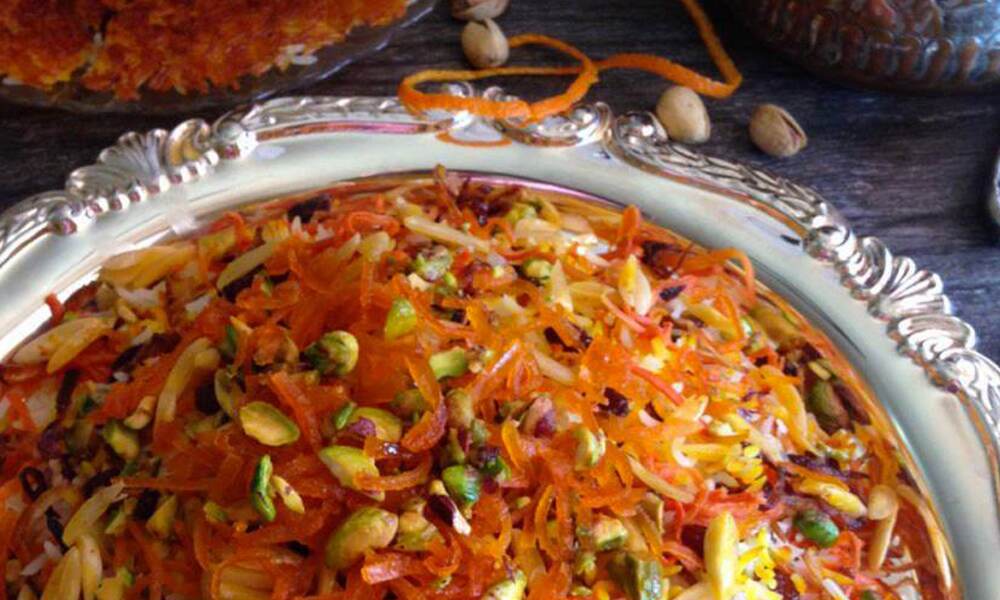
Shirin or shekar polo is a sweet rice pilaf. Toasted nuts, dried fruits, candied carrots and citrus peels are traditional toppings and the whole shebang is imbued with the subtle, sensual aroma of saffron.
Ingredients
For rice
- Basmati rice – 3 cups
- Water – 8 cups
- Kosher or sea salt – 2 tbsp
- Olive oil – ¼ cup
- Butter (cut into pieces) – 4 tbsp
- Warm water – ¼ cup
- Saffron – big pinch
For sweet garnish
- Candied citrus peel – ½ cup
- Raisins – ½ cup
- Pistachios or slivered almonds – ½ cup
- Butter – 2 to 3 tbsp
- Carrots (peeled/shredded/julienned) – 3 or 1 ½ cup
- Cinnamon – ½ tsp
- Sugar – 1 tbsp
Method
- Soak the washed rice for at least an hour or up to eight hours.
- Prepare the garnish. Add the candied citrus peel to a bowl and cover with hot water. Let soak for 30 minutes. Add the raisins to another bowl and cover with hot water. Set aside to plump for 30 minutes. Then drain both well.
- Place a dry cast-iron skillet over medium flame. Add the nuts and toast gently, stirring now and then, until the nuts are just starting to brown. Remove the nuts to a plate to cool.
- Melt the 2 or 3 tablespoons of butter in the same skillet you toasted the nuts in over medium flame. Add the shredded or julienne carrots and the cinnamon. Saute, stirring occasionally, until the carrots are cooked down somewhat, 2 or 3 minutes. Then stir in the sugar, reduce the heat to low, and continue to cook gently until the sugar gives the carrots a nice glaze and begins to caramelize a bit, 4 or 5 more minutes. Remove the glazed carrots to a bowl and set aside to cool.
- Bring the 8 cups water and salt to a boil in a large, heavy-bottomed pot. Add more salt if needed to make the water taste good. Stir in the drained rice and return to a boil. Cook the rice at a rolling boil for 4 or 5 minutes, and then immediately drain the contents of the pot through a fine-meshed sieve or colander, discarding the cooking water.
- Rinse out the pot and spread the olive oil over the bottom of the pot. Add half of the partially cooked rice to the pot and smooth it out with a wooden spoon. Next spread half of each of the garnishes evenly over the rice in the pot. Then add the rest of the partially cooked rice to the pot and smooth it out again with the wooden spoon.
- Stir the saffron into the 1/4 cup of warm water and pour the saffron water evenly over the rice in the pot. Using the handle of the wooden spoon, press five or six holes down into the rice. This will allow any steam to penetrate all the way through the rice, cooking it more evenly. Dot the top of the rice with the 4 tablespoons of butter pieces.
- Cover the pot tightly with aluminum foil and then with a lid and set over medium-high heat for 2 to 3 minutes. Reduce heat to low and simmer gently for another 30 to 45 minutes. Remove the pot from heat and set aside to rest another 15 minutes.
- Remove the cover and foil from the pot and stir the rice gently with a large fork to mix the garnishes evenly throughout. Gently stir in a little more saffron water if you would like more colour. Mound the pilaf nicely onto a serving platter and top with the remaining garnishes. Serve immediately. Goes well with chicken dishes or Persian meatballs.
Apart from marking the first day of spring, Nowruz promotes peace and solidarity in families. It’s a day that promotes friendship among people and different communities regardless of ethnicity, religion or language. To welcome Nowruz, homes are thoroughly cleaned, people wear new clothes and festive foods are prepared. The day is spent by visiting friends and relatives, exchanging festive greetings, gifts and good wishes. Nowruz 2018: Quotes, GIF Images, SMSes, WhatsApp Messages & Facebook Status to Send New Year Greetings.
(The above story first appeared on LatestLY on Aug 17, 2018 12:05 PM IST. For more news and updates on politics, world, sports, entertainment and lifestyle, log on to our website latestly.com).













 Quickly
Quickly








